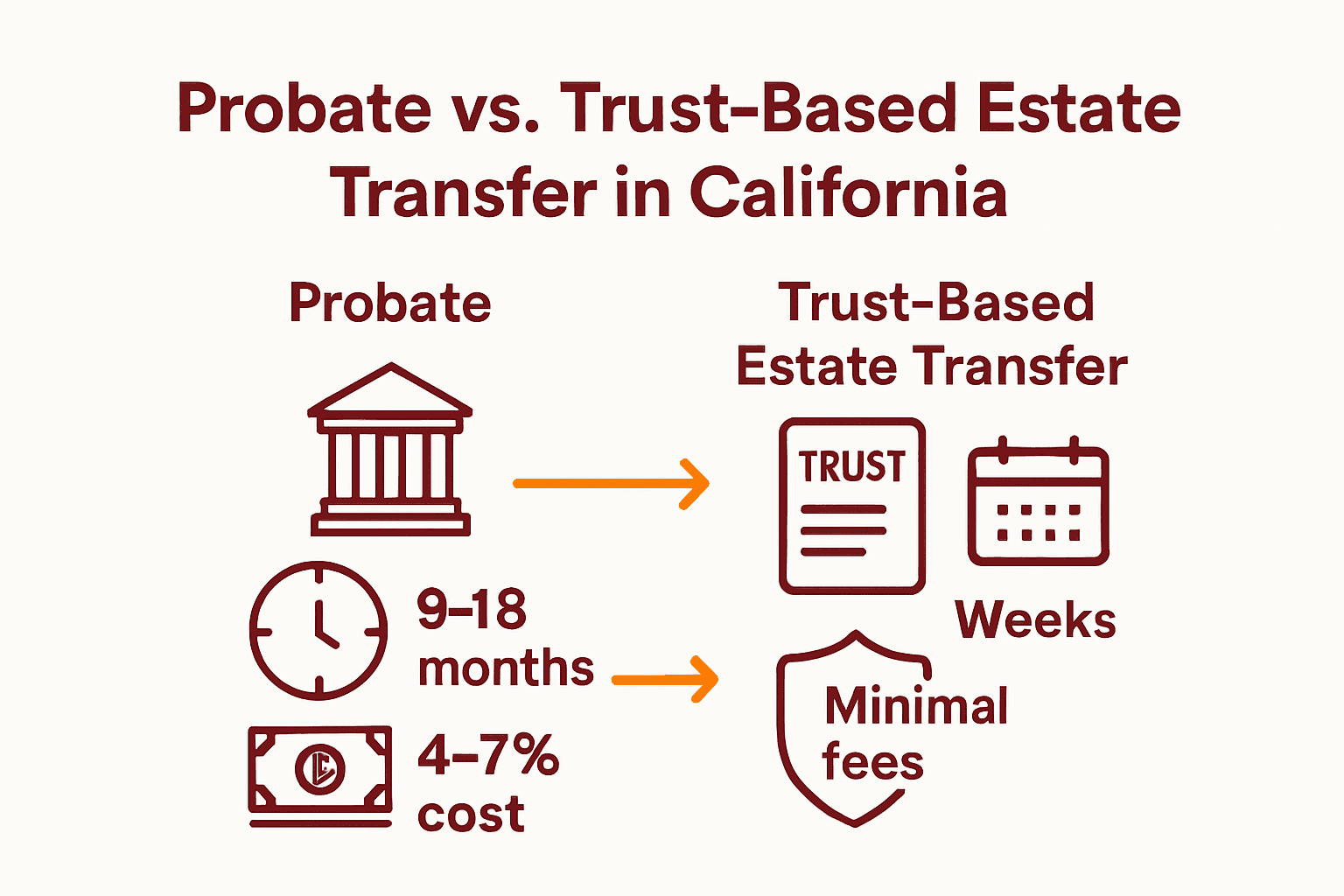
PARENTS & HOMEOWNERS: MY 7-STEP ESTATE PLANNING PROCESS WILL PROTECT YOUR HEIRS
From Creditors, Predators & Bad Choices, And Will Help You Become a (Bigger) Hero to Your Family!



How to Avoid Probate in California and Protect Your Estate
Did you know that California probate can consume up to 7 percent of your estate’s value and drag on for over a year? Most families face financial stress and delays when assets get stuck in this process. By learning how to assess your assets, set up a living trust, and transfer ownership with care, you can spare your loved ones unnecessary court battles while keeping their inheritance secure.
Quick Summary
| Key Point | Explanation |
|---|---|
| 1. Assess your assets thoroughly | Create a comprehensive inventory of all estate assets to identify potential probate risks and complexities. |
| 2. Establish a revocable living trust | Transfer asset ownership to a trust for control and to avoid probate; ensure it’s properly funded. |
| 3. Transfer ownership of key assets | Retitle assets properly to bypass probate; accurate transferring is essential to ensure all assets pass smoothly. |
| 4. Designate beneficiaries thoughtfully | Name specific beneficiaries and consider contingents to facilitate quick inheritance without court intervention. |
| 5. Regularly verify your estate plan | Schedule annual reviews to keep your estate plan current, ensuring it reflects any life changes or asset updates. |
Table of Contents
- Step 1: Assess Your Assets And Probate Risks
- Step 2: Establish A Revocable Living Trust
- Step 3: Transfer Ownership Of Key Assets
- Step 4: Designate Beneficiaries And Joint Owners
- Step 5: Verify And Maintain Your Estate Plan
Step 1: Assess Your Assets and Probate Risks
Assessing your assets and understanding your probate risks is the critical first step in protecting your California estate. In this section, you’ll create a comprehensive inventory of your assets and identify which ones might trigger complex probate proceedings.
Start by gathering documentation for everything you own. This includes real estate, bank accounts, investment portfolios, retirement accounts, life insurance policies, vehicles, and personal property with significant value. According to the guide on estate planning, a thorough inventory prevents surprises during estate settlement.
Pay special attention to California’s unique probate thresholds. As the California Judicial Branch explains, estates valued under $208,850 may qualify for simplified succession procedures. This means not every asset will require full probate court involvement. By understanding these thresholds, you can strategically structure your estate to minimize court intervention.
Critical assets to evaluate closely include:
- Real estate properties
- Investment accounts
- Business ownership stakes
- Life insurance policies
- Retirement accounts
- High value personal property
Pro Tip: Always include current market values and beneficiary designations when documenting your assets.
Guideways Legal highlights that California probate can consume 4-7% of your estate’s gross value and take 9-18 months to resolve. Understanding your asset mix now can save your family significant time and money later.
The next step is to evaluate how each asset might pass through probate and identify strategies to minimize court involvement. By creating a detailed asset map, you’re already ahead of most estate owners in protecting your family’s financial future.
Here’s a summary of California probate vs. probate-avoidance strategies:

| Feature | Subject to Probate | Avoids Probate |
|---|---|---|
| Real Estate (no trust/beneficiary) | Yes | No (in trust/TOD deed) |
| Bank Accounts | Yes | No (POD/joint ownership) |
| Investment Accounts | Yes | No (TOD registration) |
| Life Insurance | Yes (if no beneficiary) | No (if beneficiary named) |
| Personal Property | Yes | No (if assigned to trust) |
| Probate Duration | 9-18 months | Weeks to months |
| Probate Costs | 4-7% of estate | Minimal/legal fees only |
Step 2: Establish a Revocable Living Trust
Establishing a revocable living trust is your strategic shield against probate complications in California. This powerful legal tool allows you to transfer asset ownership while maintaining complete control during your lifetime.
Start by working with an experienced estate planning attorney to draft your trust document. According to Revocable Living Trusts Explained, the trust needs precise language that clearly outlines how your assets should be managed and distributed.
As Shafae Law clarifies, a living trust functions by retitling your assets into the trust. This means when you pass away, a successor trustee can collect assets, pay expenses, and distribute inheritances without court intervention. The key is ensuring your trust is properly drafted and fully funded.
Critical steps in establishing your trust include:
- Selecting a reliable successor trustee
- Identifying all assets to be transferred
- Creating detailed distribution instructions
- Naming beneficiaries explicitly
- Ensuring comprehensive asset coverage
Pro Tip: A pour-over will can capture any assets accidentally left outside the trust.
Your trust offers flexibility. You remain the primary trustee during your lifetime, giving you complete control to buy, sell, or modify assets. This means you are not surrendering control but strategically protecting your estate.
The next crucial phase involves systematically transferring asset titles into your trust’s name. This process transforms your estate plan from a theoretical document into a robust protection mechanism for your family’s financial future.

Step 3: Transfer Ownership of Key Assets
Transferring ownership of your key assets is a critical step in protecting your estate and avoiding probate in California. This process ensures your assets are strategically positioned to pass smoothly to your beneficiaries without court intervention.
According to Estate Planning for Property Owners, the transfer process requires meticulous attention to detail. Shafae Law highlights that ‘funding’ your trust involves carefully retitling various assets including real estate, bank accounts, brokerage accounts, business interests, and tangible personal property.
Nolo’s legal encyclopedia offers several specific methods for transferring asset ownership. These include transfer-on-death deeds for real estate, payable-on-death (POD) and transfer-on-death (TOD) registrations for financial accounts and vehicles, and joint ownership strategies like joint tenancy or community property with right of survivorship.
Key assets to carefully transfer include:
- Real estate properties
- Bank and investment accounts
- Business ownership interests
- Vehicles
- Valuable personal property
- Life insurance policies
Pro Tip: Incomplete asset transfer can leave some properties still subject to probate court proceedings.
Carefully document each asset transfer with precise legal paperwork. This means working closely with your estate planning attorney to ensure each asset is correctly retitled and properly integrated into your trust.
Your next step involves reviewing beneficiary designations and ensuring all documentation accurately reflects your current wishes. By methodically transferring asset ownership, you’re creating a robust shield that protects your family’s financial future from unnecessary legal complications.
Step 4: Designate Beneficiaries and Joint Owners
Designating beneficiaries and structuring joint ownership are powerful strategies to help your assets bypass probate in California. These techniques ensure your loved ones receive their inheritance quickly and efficiently without costly court intervention.
According to Avoiding Probate Disputes in California, strategic beneficiary designations can dramatically simplify asset transfer. Nolo’s legal encyclopedia provides specific methods for accomplishing this goal, including payable-on-death (POD) designations for bank accounts, transfer-on-death (TOD) registrations for securities, and transfer-on-death deeds for real estate.
The Oakland-based legal guide highlights three primary strategies for automatic asset transfer:
- Payable-on-death (POD) bank account designations
- Transfer-on-death (TOD) securities registrations
- Joint tenancy with right of survivorship
Joint ownership strategies are particularly effective. When you hold property jointly with right of survivorship, the property automatically transfers to the surviving co-owner upon one owner’s death. This means the asset completely avoids the probate process.
Pro Tip: Review and update beneficiary designations annually to reflect your current family situation and wishes.
For each financial account, insurance policy, and significant asset, carefully name specific beneficiaries. Be precise about full legal names and consider naming contingent beneficiaries in case your primary beneficiary passes away.
The next phase of your estate planning involves ensuring these designations align perfectly with your overall estate strategy. By methodically naming beneficiaries and creating joint ownership structures, you’re building a robust mechanism to protect your family’s financial future.
Step 5: Verify and Maintain Your Estate Plan
Verifying and maintaining your estate plan is a critical ongoing process that protects your assets and ensures your wishes remain accurately reflected. This final step prevents potential legal complications that could unravel your carefully constructed probate avoidance strategy.
According to The Importance of Regularly Updating Your Estate Plan, consistent review is key to effective estate planning. Guideway Legal emphasizes that common mistakes can quickly undermine your entire probate avoidance strategy.
Critical areas to monitor and verify include:
- Trust funding status
- Beneficiary designations
- Transfer-on-death deed accuracy
- Joint ownership arrangements
- Out-of-state property ownership
Nolo’s comprehensive legal guidance suggests scheduling annual reviews to catch potential issues early. Life changes such as marriages, divorces, births, deaths, or significant financial shifts can dramatically impact your estate plan’s effectiveness.
Pro Tip: Set a calendar reminder for a comprehensive estate plan review every 12 months.
Pay special attention to ensuring all assets are properly titled and integrated into your trust. Unfunded trusts or outdated beneficiary designations can inadvertently trigger probate proceedings you intended to avoid.
Your estate plan is a living document that requires consistent care and attention. By proactively maintaining and updating your plan, you’re creating a robust shield that protects your family’s financial future and preserves your legacy exactly as you intend.
Protect Your Legacy—Trust a California Probate and Estate Planning Expert
Worried about your estate getting trapped in the California probate system? If you felt overwhelmed while reading through steps like creating a revocable living trust, updating beneficiary designations, or avoiding probate court costs and delays, you are not alone. Many Californians want to secure their family’s future, yet struggle with the complex requirements of estate planning and probate avoidance. That is why our team is dedicated solely to estate planning and wills & trusts so you can avoid costly court proceedings and protect what matters most.

Take your next step toward peace of mind. Partner with us at The Law Offices of Eric Ridley for skilled guidance in trust creation, will drafting, and probate administration in California. Do not let your legacy fall victim to delays and family disputes. Contact us today and start safeguarding your estate—for your family and your future.
Frequently Asked Questions
How can I assess my assets to avoid probate in California?
To effectively avoid probate, start by creating a comprehensive inventory of your assets, including real estate, bank accounts, and investments. Document current market values and beneficiary designations to streamline the probate process if necessary.
What is a revocable living trust, and how can it help protect my estate?
A revocable living trust is a legal entity where you can transfer your assets during your lifetime, avoiding probate after your death. Work with an estate planning attorney to draft this trust, ensuring all your assets are properly retitled within 30–60 days of establishment.
How do I transfer ownership of my assets to avoid probate?
You can transfer ownership of your assets by retitling them into your revocable living trust or using transfer-on-death designations. Focus on key assets like real estate and bank accounts to ensure that they pass directly to your beneficiaries without court intervention.
What are the benefits of designating beneficiaries and joint owners?
Designating beneficiaries on accounts and establishing joint ownership enables assets to transfer directly to chosen individuals upon your death, thus bypassing probate. Review your asset beneficiary designations annually to ensure they align with your current wishes.
How often should I verify and maintain my estate plan to avoid probate issues?
You should verify and update your estate plan at least once a year or whenever significant life changes occur, such as marriage or the birth of a child. Set a calendar reminder for an annual review to ensure your assets are correctly titled, which can help you avoid unintended probate situations.
What are the typical costs and timeframes involved in California probate?
California probate costs can be 4-7% of your estate’s gross value and may take 9-18 months to complete. By employing strategies like trusts and beneficiary designations, you can minimize these costs and reduce the timeframe to just weeks or months.
Recommended
- Avoiding Probate in California: Strategies for Families in 2025 – Law Office of Eric Ridley
- Probate Alternatives in California: Smart Strategies for Families 2025 – Law Office of Eric Ridley
- Avoiding Probate Disputes in California: Protect Your Wealth in 2025 – Law Office of Eric Ridley
- How Probate Works in California: What Families Need to Know in 2025 – Law Office of Eric Ridley
